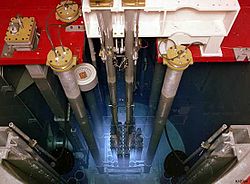Yesterday morning I noticed a very large, pronounced bluish-green glow at the base of the large crane visible on the Tepco webcam http://www.tepco.co.jp/nu/f1-np/camera/index-j.html
Later in the day the glow was almost completely gone.
I suspect - hypothesize - it is an artifact of radiation.
I was looking at possible explanations when I came across this very sad account of the Goiânia accident in Brazil in 1987 that occurred when a radiotherapy source was stolen by an unwitting scavenger named Alves.
Alves discovered a glowing blue substance when he pried up the container containing cesium-137:
Goiânia accident. Wikipedia: http://en.wikipedia.org/wiki/Goi%C3%A2nia_accident
[Excerpted] On September 16, Alves succeeded in puncturing the capsule's aperture window with a screwdriver, allowing him to see a deep blue light coming from the tiny opening he had created.[1] He inserted the screwdriver and successfully scooped out some of the glowing substance.
Thinking it was perhaps a type of gunpowder,
he tried to light it, but the powder would not ignite.
The exact
mechanism by which the light was generated was not known at the time the
IAEA report was written, though it was thought to be either fluorescence or Cherenkov radiation associated with the absorption of moisture by the source; similar blue light was observed in 1988 at Oak Ridge National Laboratory during the disencapsulation of a 137Cs source.
.....
Prussian blue
was used to internally decontaminate many people, although by the time
it was applied much of the radioactive material had already migrated
from the bloodstream to the muscle tissue, greatly hampering its
effectiveness. Urine from victims was treated with ion exchange resin to compact the waste for ease of storage....
Majia here: I had read about Cherenkov radiation previously but did not know that a blue glow is specifically linked to cesium-137.
Here is an interesting excerpt about Cherenkov radiation from Wikipedia's entry on the subject: http://en.wikipedia.org/wiki/Cherenkov_radiation
Nuclear reactors
[Excerpted] Cherenkov radiation is used to detect high-energy charged particles. In pool-type nuclear reactors, the intensity of Cherenkov radiation is related to the frequency of the fission events that produce high-energy electrons, and hence is a measure of the intensity of the reaction.
Similarly, Cherenkov radiation is used to characterize the remaining radioactivity of spent fuel rods....
Majia here: I'm speculating that what I saw was Cherenkov radiation from Cesium-137 at Fukushima. However, this is just speculation as I have no way of testing my hypothesis.


The Goiana incident shows how dangerous it can be for folks to be exposed to radioactive material.
ReplyDeleteThe total amount of material was 100 grams or about 3.5 ounces of material.
It killed 3 adults and 1 child immediately. It caused them to tear down several homes, and 100,000 people were tested for poisoning and 250 some were found to have radiation.
So Majia - a few days ago I said I'd argued with folks over and over again on what happened to Unit 3. I noticed that Terrahertz had posted a new "analysis" of what happened on the web.
My problem with it is he get's nearly everything wrong and concludes - again - that it was an SFP explosion. One of his main reasons he says that the core could not eject is that there's no hole in the #3 roof structure. I told him there was, he just wasn't looking in the right place.
I decided that everyone did not have access to the picture of the hole, so I thought I would refer you to it as well as the folks at SKF. Someone created this an posted it early on, but it was immediately attacked and removed - I saved a copy, and I present it to you here now:
http://xoom.cc/images/2012/08/10/3wIym.jpg
James